Introducing Beethoven’s Symphonies to Toddler
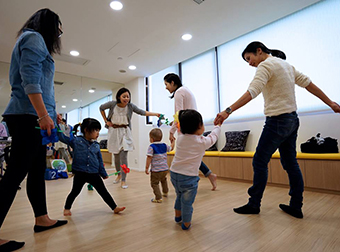
My Waltz of the Flower dance with parents and children © Affetto Music
Yes! There is a long list of classical music specially composed for children. Over the years, Saint-Saëns’ The Carnival of the Animals, Prokofiev’s Peter and the Wolf, and Tchaikovsky’s The Nutcracker helped create some of the most enjoyable moments in my music classroom for both parents and toddlers. The uplifting music resonates with the energy of these two to four year-olds. Yet, after five years of teaching, I began to question myself… “Are you still doing that same Waltz of the Flowers dance with the kids again this spring? Is it really the only suitable music that you can find from your repertoire?” True, no matter how wonderful the music is, the thought of playing it over and over again for the fifth year is definitely much less enticing… Sorry, Tchaikovsky!
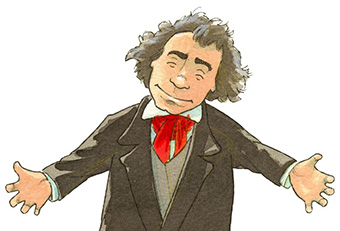
© Beethoven-Haus Bonn
Year 2020 is the year of Beethoven. Let me be honest… Beethoven was never a popular composer in my classroom. He did compose a number of “child-friendly” instrumental works – the famous Für Elise that all budding pianists struggle to perfect, the graceful “Spring” violin sonata, the tranquil Moonlight sonata included in numerous lullaby music collections… Why did I neglect such an influential composer all these years? I decided that this should be the best time to start seeking diversity for my teaching. Students, here comes Beethoven!
“Symphonies are the best representation of my true self. I always seem to hear within me the sounds of a great orchestra.” – Beethoven
After pondering my music choices for a few weeks, I settled with three of his symphonies. Children have a lot of opportunity to listen to piano music. A music appreciation session introducing “new” sounds and tone colours would be “refreshing” for me, the students, and their parents. Let this project begin!
Symphony No. 5
I love children books! Stories with colourful images are some of my best tools in attracting my students’ attention right from the beginning. They also help set the theme for each lesson. After going through my collection, I finally found a book featuring Beethoven’s iconic Fate Symphony.

Part of the book “Welcome to the Symphony” by Carolyn Sloan
and James Williamson
The famous “short-short-short-long” motif is applicable to a lot of activities. One of my favourite parent-child interactions is to have students sit on their parents’ laps, while enjoying a massage by their parents. Putting it into this context, I realized that I was actually giving an aural quiz for parents! Once they heard the motif (played by different instruments at various tempo, volume, registers…), they used soft bath sponges to massage their child according to the rhythm. I also added the rule that they must massage a different spot during every repeat. As expected, there were lots of laughter in the class as parents got too busy and clumsy when the music reached its climax. The little kids also enjoyed this massage time (or perhaps, tickle time to be exact). In certain moments, parents were puzzled when they heard a different second theme. Their hands froze in the air, peeping each other for hints. I could tell that they were truly listening to every note in details! (Note: I am more than happy if you would like to try this with your child/your students. Please be always careful with the volume level! High level volume could be too stimulating to some children or even cause damages to babies’ hearing!)
Beethoven: Symphony No. 5 in C Minor, Op. 67 – I. Allegro con brio (Zagreb Philharmonic Orchestra; Richard Edlinger, cond.)

Fingerprint painting © www.thesprucecrafts.com
For children whose motor skills are more developed, I believe this symphony is perfect to listen to while creating the best avant-garde artwork in the 21st century – fingerprint painting with Beethoven’s most popular motif. It is hard-core aural training for the three to four year-olds. The teacher also needs to give careful instructions, and be skilful enough to prevent over-excitement. I am so much looking forward to this activity and hope that I can make it happen in my own classroom!
Symphony No. 9

No, this is not a caterpillar… It is a graphic score I made for my playgroup students before they learn how to read music scores. For toddler classes, I let them point to each circle (with parents’ assistance) as they (or the parents) sang the melody “Mi Mi Fa Sol Sol Fa Mi Re Do Do Re Mi Mi Re Re” Bingo! This is the famous “Ode to Joy” from the last movement of Beethoven’s 9th. I love making these scores in circles because of this book:
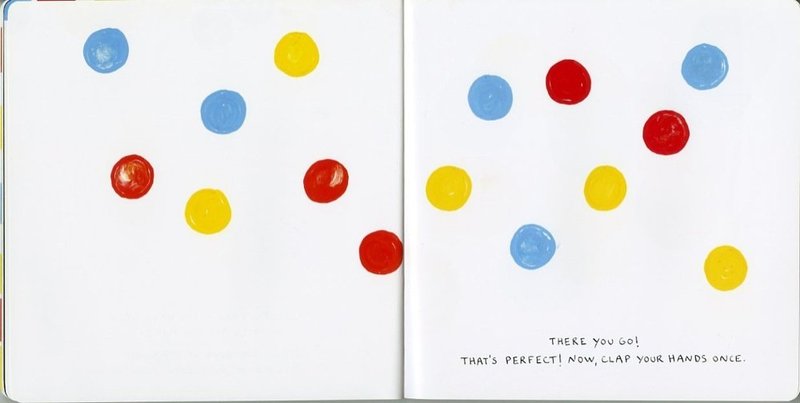
Part of the book “Press Here” by Herve Tullet © Mighty Ape
Babies and toddlers find this book fascinating! Once you show them the cover of the book, they simply cannot stop themselves from pressing, shaking, clapping, feel free to name any movement you like… . A perfect prequel to our Beethoven time!
I also used the same graphic score for three to four year-old playgroups. As long as you make sure the colours of the circles are matching with the rainbow desk bells/chime bars you have in the classroom, a little ensemble would be possible! Each of my students was responsible for one bell (i.e. colour), and they would press their bell once whenever the conductor (that was me) was pointing to that circle. Well, you don’t really need a graphic score actually, five different circles would suffice! Why not perform it in your own classroom before listening to the orchestra and singers?
Beethoven: Symphony No. 9 in D Minor, Op. 125, “Choral” – IV. Presto: O Freunde, nicht diese Tone! – Freude schöner Gotterfunken (Lisa Della Casa, soprano; Hildegard Rössel-Majdan, mezzo-soprano; Waldemar Kmentt, tenor; Otto Edelmann, bass; Wiener Singverein, choir; Vienna Symphony Orchestra; Herbert von Karajan, cond.)
Symphony No. 6
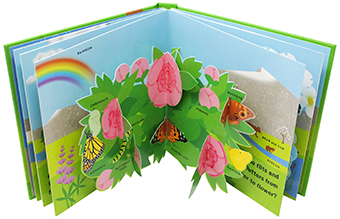
Part of the book “Spring: A Pop-up Book” by David Carter © Amazon
Every spring, my students look forward to dancing with flowers, crawling with caterpillars, and “flying” with butterflies. Beethoven’s Pastoral Symphony portrayed the perfect countryside for them this year! I randomly picked a pop-up book about spring. I love doing creative movements with children while listening to classical music (despite the fact that I am not well-trained in dance/movement). This is my definition of “dance”:
Children, see, this is such a beautiful garden! Let’s have a stroll around. There! Some blooming flowers are swinging in the light breeze from different directions! Oh! I see a lazy caterpillar there! What is it doing? Look! Some butterflies are flapping their wings. Where do you think they are going? Oh! Listen, where are they hiding now?
Before playing the music, I created a simple narrative to give some movement ideas for my students. I tried my best not to demonstrate my own movements too much because this would take away their imagination. After such preparation, the music began:
Beethoven: Symphony No. 6 in F Major, Op. 68, “Pastoral” (South West German Radio Symphony Orchestra, Baden-Baden and Freiburg; Hans Rosbaud, cond.)
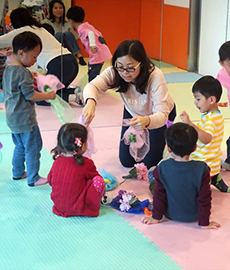
Helping my students with their scarf butterflies
in one of my “Spring” classes © Musikitchen
We enjoyed our “dance” in the garden for almost four minutes, before the insects “took their nap”. I skipped around the classroom with them when the violins were presenting the main theme. As the theme developed, I simply pointed to the flowers and insects from my book, letting them improvise their movements. Of course, if your objective is not as simple as music appreciation, you may want to give more structures and guidance for this activity.
For me, introducing music across genres and instrumental colours are essential as an early childhood educator. Bringing Beethoven’s symphonies to my students is only the first step. I hope this idea could also inspire you, as a parent or a teacher, to always seek to provide more diversity in the children’s world.
After graduating with a degree in English Literature, Eliza continued her journey of discovery in the field of classical music. A beautiful read, an enchanting melody, and a peaceful time with her harp are some of her most beloved moments. Currently, she’s working as an early childhood music educator, translator and editor for Interlude. She is currently undergoing her training as a harp therapist.
